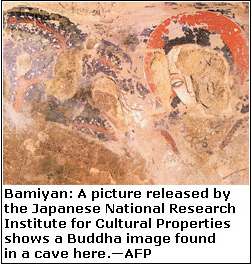Cave Art: Afghanistan
Contents |
Cave Art: Afghanistan
This is a collection of articles archived for the excellence of their content. Readers will be able to edit existing articles and post new articles directly |
World’s first oil paintings found in Afghan caves
By AFP, Jan 25,2008
Paintings dated to A.D. 650
Forget Renaissance Europe. The world’s first oil paintings go back nearly 14 centuries to murals in Afghanistan’s Bamiyan caves, a Japanese researcher says.
Buddhist images painted in the central Afghan region, dated to around 650 AD,are the earliest examples of oil used in art history, says Yoko Taniguchi, an expert at Japan’s National Research Institute for Cultural Properties.
A group of Japanese, European and US scientists are collaborating to restore damaged murals in caves in the Bamiyan Valley, famous for its two gigantic statues of the Buddha which were destroyed by the Taliban in 2001.
Thousands of Buddhas
In the murals, thousands of Buddhas in vermilion robes sit cross-legged, sporting exquisitely knotted hair.
Other motifs show crouching monkeys, men facing one another or palm leaves delicately intertwined with mythical creatures. The paintings incorporate a mix of Indian and Chinese influences, and are most likely to be the works of artists travelling on the Silk Road, which was the largest trade and cultural route connecting the East and the West.
19 of them are oil paintings
The Los Angeles-based Getty Conservation Institute analysed 53 samples extracted from the murals. Using gas chromatography methods, the researchers found that 19 had oil in the paint. “Different types of oil were used on the dirt walls with such a sophisticated technique that I felt I was looking right at a mediaeval board painting dating from 14th or 15th century Italy,” Taniguchi told AFP.
The discovery would reverse common perceptions about the origins of oil paintings. The technique is widely believed to have emerged in Europe leading into the Renaissance, which flowered from 1400 to 1600.— AFP
